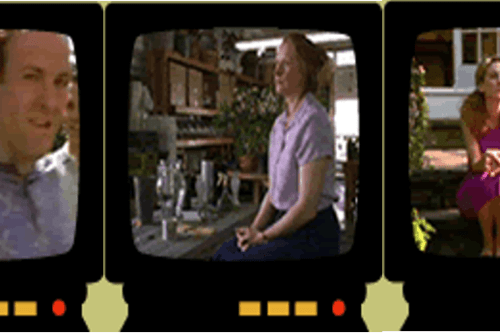Just as the televisual dramatic form provides a space for inciting a discourse of female subjectivity—presenting it for an audience, staging dilemmas, allowing the viewer to observe and read a performance—the clinical space also functions as an incitement to discourse. Under his watchful gaze, and removed from close kin, Claire’s revelations become defined as an emotional display, a disclosure of family dysfunction and a female self laid bare. Made to talk about her feelings of growing up reveals a discourse of female invisibility and marginality. An unexpected addition to the Fisher clan, born some 14 years after David (Michael C. Hall), Claire feels she missed out (or so Gary interprets). No one noticed her growing up—her elder brother Nate had left home, her other sibling was closed-down and closeted, her father too busy with dead bodies in the basement, and her mother preoccupied with keeping house. Putting her stories of childhood into the language of psychoanalysis imposes knowledge on her about what she has to say and uses it to construct a standard narrative in which the female child learns about nonexistence.
Prompted by her sessions with Gary, Claire works through these invisibility issues in her dreams. Relaxing with a cigarette in front of the television, watching old home movies, she confronts her dead father about her undocumented childhood: “How come there are no home movies of me as a kid?” (“Knock, Knock,” episode 13). The super-8 camera images of the happy and wholesome-looking Fisher boys enjoying Easter complete with chocolate eggs and chicks under the watchful eye of an adoring Nathaniel (Richard Jenkins) are undercut by the cynicism and shared laughter between father and daughter. He may confirm her suspicions (“after you came along I guess we felt . . . been there, done that”), and she may be aggrieved (“yeah I know, and it made me feel totally secondary, thank you”), but her indignation seems somehow faux—as illusionary as the blissful memories caught on celluloid (and let us not forget that Claire never believed this family was ever happy). The dream sequence may actually be about her future (her father says, “maybe some of that attention you never got will motivate you to get off your ass and do something interesting with you life,” but he is merely a device through which to reveal her own thoughts); however, it is her use of the Oedipal language of invisibility and exclusion already identified by Gary that troubles the text. Later, she fantasizes that her father is videotaping her skipping down the stairs. While her absent female body is now replaced by an infantilized one complete with pigtails (“I thought this is what you wanted,” she imagines her father saying), the incongruous (if not amusing) sight of Claire dressed as a little girl reminds the viewer that Claire is struggling with an Oedipal language that defines female behavior as neurotic, a symptom of invisibility.
Claire bitterly objects to the attention paid to what she does with the rest of her life when she had long been invisible. But does not such a complaint coincide with the moment when Claire starts having sex? Of course the reason she is seeing Gary in the first place is because of her sexual relationship with a fellow student, Gabriel Dumas (Eric Balfour). Foucault draws our attention to how scientific knowledge in the nineteenth century delivered up the female body to a process of “hysterization” (104). Medical and psychiatric institutions analyzed the female body as “saturated with sexuality” (Foucault 104) and inherently pathological. Claire is endlessly required to rehearse her reasons for being attracted to Gabe (“A Private Life,” episode12; “The Plan,” episode 16). Summoned back to see Gary under the threat of suspension, Claire struggles to articulate her fury at him for permitting the police to crash their last session (to find out what she knows about Gabe’s whereabouts) (“Driving Mr. Mossback,” episode 17). But the more she tries to comprehend the complex emotional terrain of her internal life, the more Gary steps in to narrate her feelings for Gabe and pathologize what she has to say when she falters. Rationalizing meaning—drawing out the confession, alerting her to hidden (sexual) desire—prevents Claire from speaking in certain ways. No wonder she is reduced to petulantly knocking over the coffee mug.

In the aptly titled episode, “The Invisible Woman” (episode 18), Gary alerts her to the “sexual tension between them.” It is a strangely inappropriate moment, coming after Claire’s violent outburst toward Parker McKenna (Marina Black) for cheating on the SATs. Despite Gary telling her she is displacing, he goes on to say, “And now is probably as good a time as any to talk about the sexual tension between us.” Claire lets out an incredulous “What?” He continues: “It exists. It is a normal part of transference and counter-transference. We should both acknowledge it is out there and will never be acted upon.” Claire is stunned—and silenced. Seen from her position (and let us not forget how the mise-en-scène of the office, with its closed Venetian blinds and counselor peering out from behind his desk, hems her in and often leaves her prowling around the room like a trapped animal), the intrusive process of probing for any traces of sexuality and desire, of wrenching out the most stubborn confessions, and of opening the female subject to unremitting scrutiny is made uncomfortably visible here.
Although Gary aims to build up her self-esteem, confidence, and identity (he is after all responsible for getting her into the Sierra Crossroads program and passing on details about the LAC-Arts school), the therapeutic process nevertheless circumscribes Claire’s self-articulation since only certain things can be uttered—despite him telling Claire she can say anything. Visibly disappointed and annoyed about what she sees around her, and the ways she is interpreted within the male confessional space, Claire often fails to give adequate voice to her frustrations. One need only think of how Gary responds to her rant about making her life matter rather than getting into college, with the suggestion that she attend the outward bound program designed to build character and get her out of her head, for another example of a tactical strategy designed to police the dysfunctional adolescent female (“Brotherhood,” episode 7). She is often lost for words, silenced by thwarted rage, or provoked to say things she does not quite mean. Here, rigor mortis is not the preserve of the cadaver only. It also speaks of the stultifying discourses available to the female subject when she attempts to speak differently. Claire’s frustration seems to me less about her rejection of normative female social roles—daughter, sister—than about the limits of discourse to adequately express and describe her experiences, her desires, her identity. But try she must. Just as each episode is structured by liminality—between someone dying in the opening and funeral service at the end—where a space opens up for suspending rules and challenging taboo, Claire represents within the narrative logic of Six Feet Under another kind of liminal space—a gendered liminality in which the possibilities for representing female identity differently are, for better or worse, negotiated.



